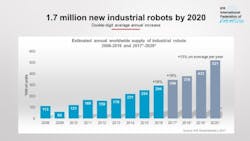Global industrial robot supply to increase significantly over next few years
By 2020, more than 1.7 million new industrial robotswill be installed infactoriesaround the world, which represents double digit annual growth from now until then, according to theInternational Federation of Robotics(IFR).
In terms of units, it is estimated that by 2020, the worldwide stock of operational industrial robots will increase from about 1,828,000 units at the end of 2016 to 3,053,000 units. This, according to the IFR, represents an average annual growth rate of 14% between 2018 and 2020. Projections such as these are aided by significant growth that is expected in the top markets in the world over the next year.
In the Asia-Australia region, for example, 2017 robot installations are estimated to increase by 21%, while robot supplies in the Americas will rise by 16%, and by 8% in Europe. Growth like this is being achieved, according to the IFR, because of a response to faster business cycles and the requirement to produce with greater flexibility tailored to customer demand in all manufacturing sectors.
"Robots offer high levels of precision and their connectivity will play a key role in new digital manufacturing environments," said Joe Gemma, President of the International Federation of Robotics. "ncreasing availability enables more and more manufacturers from companies of all sizes to automate."
Accounting for 74% of the total robot sales volume in 2016 are the top five markets in the world: China, South Korea, Japan, the United States and Germany, which saw the following growth in 2016:
- China (27%, about 87,000 industrial robots sold)
- South Korea (8%, about 41,400 robots sold)
- Japan (10%, about 38,600 robots sold)
- United States (14%, about 31,400 robots sold)
- Germany (Less than 1%, 20,039 robots sold)
Future trends
Future trends that could drive growth, according to the IFR, include Industry 4.0 and the smart factory and small-to-medium sized manufacturers that will look to automate:
- Smart factory: Within Industry 4.0, manufacturers will integrate robots into factory-wide networks of machines and systems. Robot manufacturers, according to the IFR, are already developing and commercializing new service models based on real-time data collected by sensors attached to robots. Analysts are predicting a rapidly-growing market for cloud robotics in which data from one robot is compared to data from other robots in the same or different locations. Cloud networks enable connected robots to perform the same activities, which will be used to optimize parameters of the robot’s movement such as speed, angle or force. Ultimately, explains the IFR, the advent of big data in manufacturing could redefine the industry boundaries between equipment makers and manufacturers.
- Small-to-medium sized manufacturers: Some robot manufacturers are considering leasing models to accelerate adoption by small-to-medium-sized manufacturers. Simplification is a key trend for this market segment, according to the IFR, which says that the ongoing need for robots that are easier to use and to program, and the increasing need for ever more flexible automation has initiated the development of smarter solutions. It is important to provide easy-to-use robots that can easily be integrated into and operated in standard production processes, said the IFR, as robots that are uncomplicated to use will enable the deployment of industrial robots in many industries to sustain efficient and flexible manufacturing.
View a presentation on the World Robotics 2017 report.
View a press release.
Purchase the report.
Share your vision-related news by contacting James Carroll, Senior Web Editor, Vision Systems Design
To receive news like this in your inbox, click here.
Join our LinkedIn group | Like us on Facebook | Follow us on Twitter
About the Author

James Carroll
Former VSD Editor James Carroll joined the team 2013. Carroll covered machine vision and imaging from numerous angles, including application stories, industry news, market updates, and new products. In addition to writing and editing articles, Carroll managed the Innovators Awards program and webcasts.
